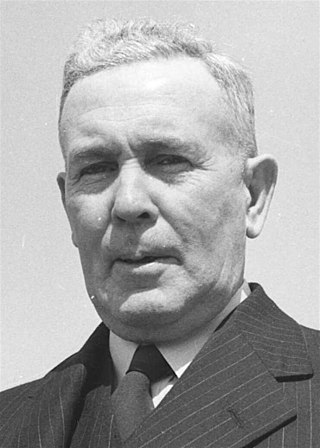
The Australian Labor Party (ALP), also simply known as Labor, is the major centre-left political party in Australia and one of two major parties in Australian politics, along with the centre-right Liberal Party of Australia. The party has been in government since being elected at the 2022 federal election, and with political branches in each state and territory, they currently form government in New South Wales, Queensland, South Australia, Victoria, Western Australia, the Australian Capital Territory, and the Northern Territory. As of 2023, Tasmania is the only state or territory where Labor forms the opposition. It is the oldest continuous political party in Australian history, being established on 8 May 1901 at Parliament House, Melbourne, the meeting place of the first federal Parliament.

Joseph Benedict Chifley was an Australian politician and train driver who served as the 16th prime minister of Australia from 1945 to 1949. He held office as the leader of the Australian Labor Party (ALP), having previously served as the treasurer of Australia under Prime Minister John Curtin and later himself from 1941 to 1949. He was notable for defining Australia's post-war reconstruction efforts.

John Christian Watson was an Australian politician who was the third prime minister of Australia, in office from 27 April to 18 August 1904. He was the inaugural federal leader of the Australian Labor Party (ALP) from 1901 to 1907 and was the first member of the party to serve as prime minister.

John Curtin was an Australian politician who served as the 14th prime minister of Australia from 1941 until his death in 1945. He held office as the leader of the Australian Labor Party (ALP), having been most notable for leading the country through the majority of World War II, including all but the last few weeks of the war in the Pacific. Curtin's leadership skills and personal character were acclaimed by his political contemporaries and he is frequently ranked as one of Australia's greatest prime ministers and political leaders.

Francis Michael Forde was an Australian politician who served as the 15th prime minister of Australia from 6 to 13 July 1945. He was deputy leader of the Australian Labor Party from 1932 to 1946 and served as prime minister in a caretaker capacity following the death of John Curtin. He is the shortest-serving prime minister in Australia's history.

Simon Findlay Crean was an Australian politician and trade unionist. He was the leader of the Australian Labor Party (ALP) and leader of the opposition from 2001 to 2003. He represented the seat of Hotham in the House of Representatives from 1990 to 2013 and was a cabinet minister in the Hawke, Keating, Rudd and Gillard governments.

Kim Edward Beazley was an Australian politician who served as a member of the House of Representatives from 1945 to 1977, representing the Labor Party. He was Minister for Education in the Whitlam government from 1972 to 1975.

John Joseph Cahill, also known as Joe Cahill or J. J. Cahill, was a long-serving New South Wales politician, railway worker, trade unionist and Labor Party Premier of New South Wales from 1952 to his death in 1959. Born the son of Irish migrants in Redfern, New South Wales, Cahill worked for the New South Wales Government Railways from the age of 16 before joining the Australian Labor Party. Being a prominent unionist organiser, including being dismissed for his role in the 1917 general strike, Cahill was eventually elected to the Parliament of New South Wales for St George in 1925.

Centenary House was a building in Canberra, Australia. It consisted of five levels and was located at 19 National Circuit, Barton.

Edward John Ward was an Australian politician who represented the Australian Labor Party (ALP) in federal parliament for over 30 years. He was the member for East Sydney for all but six-and-a-half weeks from 1931 until his death in 1963. He served as a minister in the Curtin and Chifley governments from 1941 to 1949, and was also known for his role in the ALP split of 1931.

The leader of the Australian Labor Party is the highest political office within the federal Australian Labor Party (ALP). Leaders of the party are chosen from among the sitting members of the parliamentary caucus either by members alone or with a vote of the party’s rank-and-file membership. The current leader of the Labor Party, since 2019, is Anthony Albanese, who has served as the prime minister of Australia since 2022. There have been 21 leaders since 1901 when Chris Watson was elected as the inaugural leader following the first federal election.

Australian Young Labor (AYL), also known as the Young Labor Movement or simply Young Labor, is the youth wing of the Australian Labor Party (ALP) representing all party members aged between 15 and 26. The organisation operates as a federation with independently functioning branches in all Australian states and territories which serve under the relevant state or territory branch of the federal Labor Party, often coming together during national conferences and federal elections. Young Labor is the oldest continuously operating youth wing of any political party in Australian history, being founded in 1926.

Keppel Earl Enderby was an Australian politician and judge. Enderby was a member of the House of Representatives, representing the Australian Labor Party between 1970 and 1975 and became a senior cabinet minister in the Gough Whitlam government. After politics, he was appointed a Justice of the Supreme Court of New South Wales.
Belinda Jane Neal is a former Australian federal politician. She was a Member of the House of Representatives representing the electorate of Robertson between 2007 and 2010; and representing the state of New South Wales in the Senate from 1994 to 1998, both on behalf of the Australian Labor Party.

Allan Duncan Fraser was an Australian politician and journalist. He served as a member of the House of Representatives from 1943 to 1966 and from 1969 to 1972, representing the Division of Eden-Monaro for the Labor Party.
Political funding in Australia deals with political donations, public funding and other forms of funding received by politician or political party in Australia to pay for an election campaign. Political parties in Australia are publicly funded, to reduce the influence of private money upon elections, and subsequently, the influence of private money upon the shaping of public policy. After each election, the Australian Electoral Commission distributes a set amount of money to each political party, per vote received. For example, after the 2013 election, political parties and candidates received $58.1 million in election funding. The Liberal Party received $23.9 million in public funds, as part of the Coalition total of $27.2 million, while the Labor Party received $20.8 million.

Mark Victor Arbib is an Australian former Labor Party politician and trade unionist, who was an Australian Senator for New South Wales from 2008 to 2012.

Zdenko Matthew "Zed" Seselja is an Australian politician who was a Senator for the Australian Capital Territory from 2013 to 2022, representing the Liberal Party. He was the Minister for International Development and the Pacific in the Morrison government from December 2020 to May 2022, and previously served as an assistant minister in the Morrison and Turnbull governments since 2016.
In Australian politics, leadership spill is a colloquialism referring to a declaration that the leadership of a parliamentary party is vacant and open for contest. A spill may involve all or some of the leadership positions. Where a rival to the existing leader calls for a spill it may also be called a leadership challenge. When successful, it is often said that the former leader has been "rolled". In Australian English the colloquial use of the word "spill" seems to have begun in the mid-1940s with the contest to replace Prime Minister John Curtin after his death on 5 July 1945.
This is a list of the members of the Australian House of Representatives in the 17th Australian Parliament, which was elected at the 1943 election on 21 August 1943. The incumbent Australian Labor Party led by Prime Minister of Australia John Curtin defeated the opposition Country Party led by Arthur Fadden with coalition partner the United Australia Party (UAP) led by Billy Hughes. On 21 February 1945, the parliamentary UAP was dissolved and replaced by the newly established Liberal Party.















